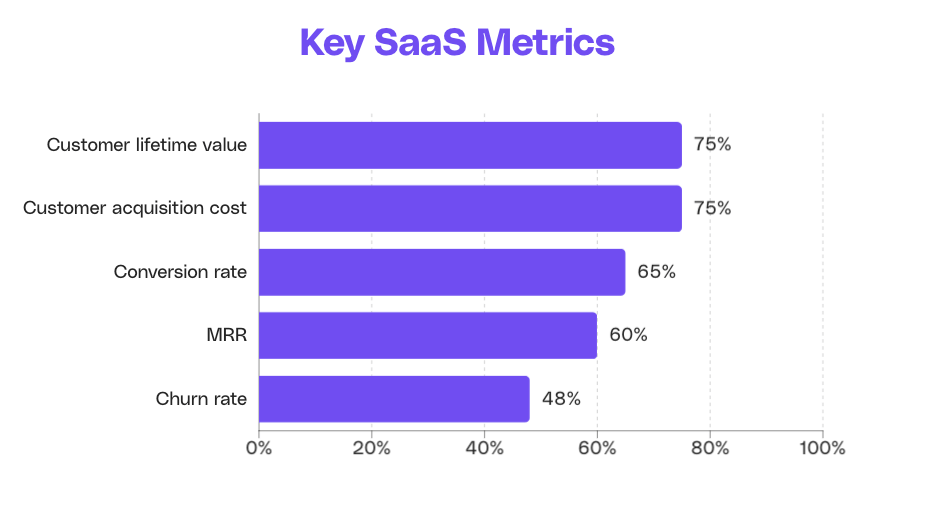The Software-as-a-Service (SaaS) business model has become increasingly popular. However, succeeding in this competitive industry requires more than just a great product or service. It requires diligent monitoring and analysis of key SaaS metrics that truly matter.
By understanding these metrics and their impact on business growth, decision-making, and overall performance, SaaS companies can make informed strategic decisions to drive success.
| Key Element | Description | Tips for Optimization |
|---|---|---|
| Definition of SaaS Metrics | SaaS metrics are key performance indicators that provide insights into a company's performance. | Regularly track and analyze to identify trends and make data-driven decisions. |
| Role in Business Growth | SaaS metrics help gauge overall growth, revenue generation, customer acquisition, and retention. | Focus on metrics that highlight areas for improvement and opportunities. |
| Influence on Decision Making | Accurate metrics guide pricing strategies, resource allocation, and overall decision-making. | Use metrics to align cross-functional teams and drive cohesive decision-making. |
| Key SaaS Metrics | Includes MRR, CAC, CLV, churn rate, and NPS. | Monitor these metrics to improve customer acquisition, retention, and overall growth. |
Understanding the importance of SaaS metrics
Before diving into the specific metrics, it's essential to comprehend the significance of SaaS metrics in driving business growth.
📊 SaaS metrics act as a compass, providing valuable insights into various aspects of a company's performance. By measuring and tracking these metrics, businesses can identify trends, measure the effectiveness of strategies, and make data-driven decisions to optimize performance.
Furthermore, SaaS metrics not only offer a snapshot of a company's current standing but also provide a roadmap for future success.
By analyzing these metrics over time, businesses can forecast growth, anticipate challenges, and proactively adjust their strategies to stay ahead in a competitive market landscape.

The role of SaaS metrics in business growth
Effective business growth requires a deep understanding of the metrics that contribute to success. SaaS metrics serve as key performance indicators (KPIs) that help companies gauge their overall growth trajectory.
These metrics provide insights into revenue generation, customer acquisition and retention, profitability, and more, enabling businesses to identify areas of improvement and capitalize on opportunities.
Moreover, SaaS metrics offer a comprehensive view of the customer journey, allowing businesses to tailor their products and services to meet evolving needs.
By analyzing metrics such as customer lifetime value, churn rate, and customer acquisition cost, companies can fine-tune their offerings, enhance customer satisfaction, and foster long-term relationships with their client base.
How SaaS metrics influence decision making
When it comes to decision-making, having accurate and up-to-date information is crucial. SaaS metrics play a pivotal role in influencing decisions at various levels within a company.
From setting pricing strategies to allocating resources, understanding these metrics allows businesses to make informed decisions that align with their growth objectives.
Furthermore, SaaS metrics empower cross-functional teams within an organization to collaborate effectively towards common goals.
By providing a shared set of performance indicators, these metrics facilitate communication, foster transparency, and drive alignment across departments, ultimately leading to cohesive decision-making processes and streamlined operations.
Key SaaS metrics to monitor
Now that we understand the importance of SaaS metrics, let's explore some key metrics that every SaaS company should monitor.
Monthly recurring revenue (MRR) and annual recurring revenue (ARR)
MRR is one of the most crucial metrics for SaaS companies as it represents the predictable revenue stream from subscriptions. Monitoring MRR allows businesses to assess their revenue stability, identify growth trends, and evaluate the effectiveness of pricing strategies.
Tracking MRR over time can provide valuable insights into the health of a SaaS business. For example, consistent month-over-month growth in MRR indicates a healthy and scalable business model.
On the other hand, a decline in MRR may signal issues such as customer churn or pricing problems that need to be addressed promptly.

By multiplying MRR by 12, it is possible to obtain ARR. This value is useful to understand the bigger picture of a company's performance and compare annual values.

Customer acquisition cost (CAC)
CAC represents the cost incurred to acquire a new customer. By measuring CAC, SaaS companies can evaluate the effectiveness of their sales and marketing efforts.
A lower CAC indicates efficient customer acquisition strategies, while a higher CAC may require adjustments to improve customer acquisition efficiency.
Calculating CAC involves factoring in expenses related to sales and marketing activities, such as advertising costs, salaries of sales teams, and overhead costs.
By optimizing CAC, SaaS companies can maximize their return on investment and drive sustainable growth in customer acquisition. There are several ways to minimize CACs:
- Choose the best acquisition channels, e.g. carefully deciding when to use paid and organic acquisition channels.
- Use the right number of acquisition channels: more channels might allow you to reach a wider network, but this should be financially sustainable. Optimize your funnel to improve this.
- Identify your best customers: is one of your acquisition channel producing higher-value customers? If so, redirecting resources towards this channel may be a good investment.
- Start user and affiliate referral programs: these tend to be lower cost than paid ads, and allow you to improve customer retention
- Use marketing automation tools to improve efficiency.

Customer lifetime value (CLV)
CLV refers to the total revenue a business can expect from a customer over their lifetime. Understanding CLV helps SaaS companies determine the value of acquiring and retaining customers. By increasing CLV, businesses can improve profitability and focus on customer retention strategies.
Enhancing CLV can involve several aspects:
- Deliver exceptional customer experiences, as these will satisfy your customers and keep them hooked to your product.
- Ask customers for feedback: if customers feel heard and valued, they are more likely to feel as if they are impacting the company's future.
- Offer referral and loyalty programs: these are cost-effective ways to keep your customers happy and incentivize them to advocate for your brand.
- Provide targeted and personalised campaigns: this will further increase customers' feeling of being valued, while increasing the likelihood of new purchases.
- Offer additional value through upselling or cross-selling, as well as content production.
By prioritizing CLV, SaaS companies can build a loyal customer base, increase profitability, and drive sustainable revenue growth over time.

CLV:CAC ratio
The CLV:CAC ratio is crucial for assessing the efficiency of customer acquisition efforts relative to the value derived from those customers over their lifetime. A higher ratio indicates that the revenue from customers significantly exceeds the cost of acquiring them, signaling a healthy business.
It is simply measured by dividing CLV by CAC. To improve it, companies should either increase CLV and/or decrease CACs, using the strategies mentioned above.

Churn rate
Churn rate indicates the percentage of customers who cancel their subscriptions within a specific timeframe. A high churn rate often highlights issues like customer dissatisfaction, unmet needs, or a weak value proposition.
Analyzing churn rate helps companies identify root causes and areas for improvement. By understanding these factors, businesses can create targeted strategies to boost customer satisfaction and retention.
To reduce churn, companies should focus on several aspects, including:
- Regular new features and improved customer support.
- Easy onboarding.
- Personalised communication and frequent customer engagement.
- Tailored recommendations and training sessions to educate customers on how to extract the most value from your product.
- Track profiles at risk (particularly in B2B), as this will make you more proactive.
- Offer incentives, such as discounts and referral programs.

Conversion rate
The conversion rate is a vital metric for measuring the effectiveness of a SaaS company's marketing and sales strategies. It indicates the percentage of prospects who take a desired action, such as making a purchase or signing up for a service.
The lead conversion rate specifically measures the percentage of leads that become paying customers. By improving this rate, companies can maximize the return on their lead generation efforts, ensuring that more potential customers are effectively nurtured through the sales funnel.

The signup rate focuses on the percentage of visitors who register for a service or product. Enhancing this rate involves optimizing the user experience, simplifying the signup process, and offering compelling incentives for new users. Increasing sign-ups may also lead to increased free-to-paid conversions.

Overall, the general conversion rate reflects the success of converting prospects at various stages of the customer journey. By prioritizing conversion rate optimization, SaaS companies can boost customer acquisition, enhance revenue, and achieve sustainable growth.

Customer retention rate
The customer retention rate reflects the percentage of customers who continue to use a product or service during a specific period, indicating the effectiveness of retention strategies.
High customer retention rates are essential for long-term profitability and growth. They demonstrate customer satisfaction, loyalty, and the company's ability to deliver ongoing value.
Some common strategies to improve the customer retention rate include:
- Making the customer experience seamless at all steps, providing excellent support and asking for feedback.
- Implementing loyalty and referral programs.
- Expand your value proposition, to target and retain a wider range of clients.
- Contact your clients regularly, building a relationship with them and understanding their perspective.
- Personalise as much as you can, as it will make clients feel valued.
- Host events, webinars and similar activities to engage with your clients.
- Thank your clients - whether through simple messages or personalised physical gifts, acts of gratitude will help build a deeper relationship with your clients.

Revenue retention rate
The revenue retention rate measures the percentage of recurring revenue retained from existing customers over a specific period. High revenue retention indicates that customers continue to find value in the product, leading to sustained revenue.
Improving revenue retention involves enhancing customer satisfaction, providing exceptional support, offering flexible pricing tiers, and analysing data on customer behaviour.

Revenue growth rate
The revenue growth rate measures how quickly a company's revenue is increasing over a specific period. This metric is crucial for evaluating a company's performance and future prospects.
A healthy revenue growth rate indicates successful customer acquisition and retention efforts, demonstrating strong market demand.
To maintain a healthy revenue growth rate, companies should focus on effective marketing and sales strategies to attract new customers, deliver exceptional service to retain existing ones, and continuously innovate their product offerings. By prioritizing these areas, companies can achieve sustained revenue growth and long-term success.

Customer retention cost
Customer retention cost refers to the expenses incurred to retain existing customers, including costs related to customer support, loyalty programs, and personalized marketing efforts.
Evaluating this metric allows SaaS companies to identify opportunities for optimizing resources to increase customer satisfaction and reduce churn.
By closely monitoring and managing customer retention costs, companies can develop more cost-effective strategies that enhance the customer experience without overspending. Lowering these costs can significantly impact overall profitability, as retaining existing customers is often more cost-effective than acquiring new ones.
Effective management of customer retention costs involves streamlining support processes, leveraging automation for personalized communication, and continually assessing the value of retention initiatives.

Net promoter score (NPS)
Net Promoter Score (NPS) is a key metric that measures customer loyalty and satisfaction by asking customers how likely they are to recommend a company's product or service to others. Evaluating NPS helps companies gauge customer sentiment and identify areas for improvement.
A high NPS indicates strong customer loyalty and satisfaction, while a low NPS highlights potential issues that need to be addressed.
Improving NPS involves focusing on delivering exceptional customer experiences, addressing pain points, and fostering positive relationships. Regularly collecting and acting on customer feedback is crucial for making meaningful improvements.
By prioritizing NPS, SaaS companies can build stronger customer relationships, reduce churn, and drive long-term growth.

Unlock viral growth with Cello's P2P referral program
As you focus on the SaaS metrics that matter, consider the untapped potential of peer-to-peer referrals to lower your Customer Acquisition Cost and boost your Monthly Recurring Revenue. Cello transforms your users into powerful growth engines, seamlessly integrating a referral program into your SaaS product. With minimal development time and a success-based pricing model, Cello empowers you to leverage user-led growth, automate rewards, and effortlessly manage your program's performance. Ready to see how Cello can revolutionize your growth strategy? Book a demo and start turning your users into your most valuable growth channel today.
Resources
Related Articles

Complete Guide to your B2B Referral Program
Want to get started with B2B referrals? Check out our complete guide to your B2B referral ...

The 4 Referral Program Categories for B2B SaaS (2025 Guide + Examples)
Learn how to get started with referral programs for B2B SaaS. Understand what type of referral ...

How to use incentives to drive velocity of your growth loops
This article is written together with Wes Bush, founder and CEO of ProductLed and one of the ...
